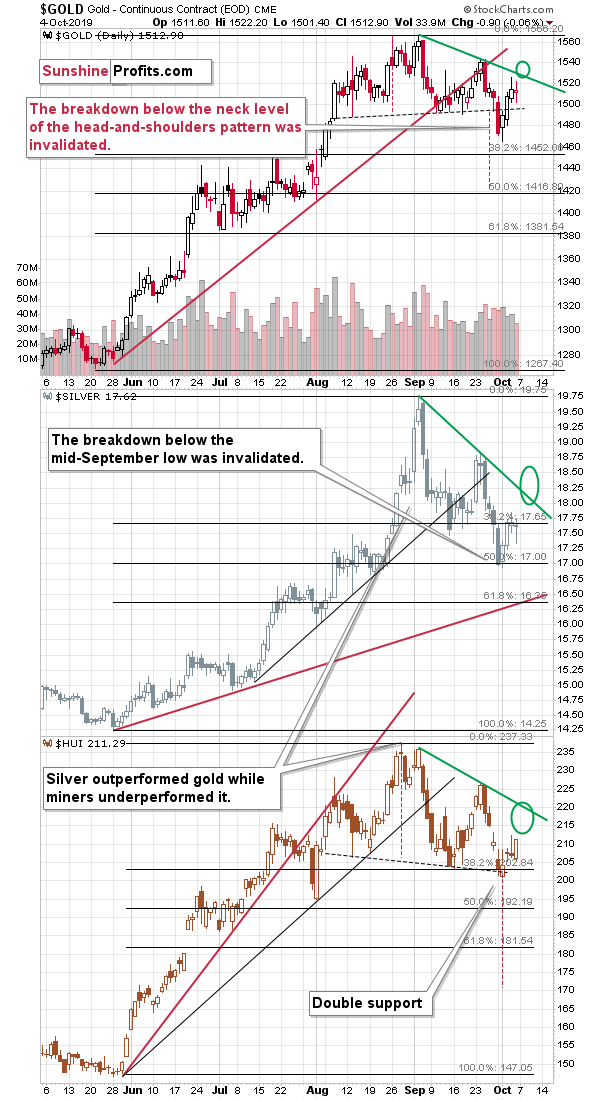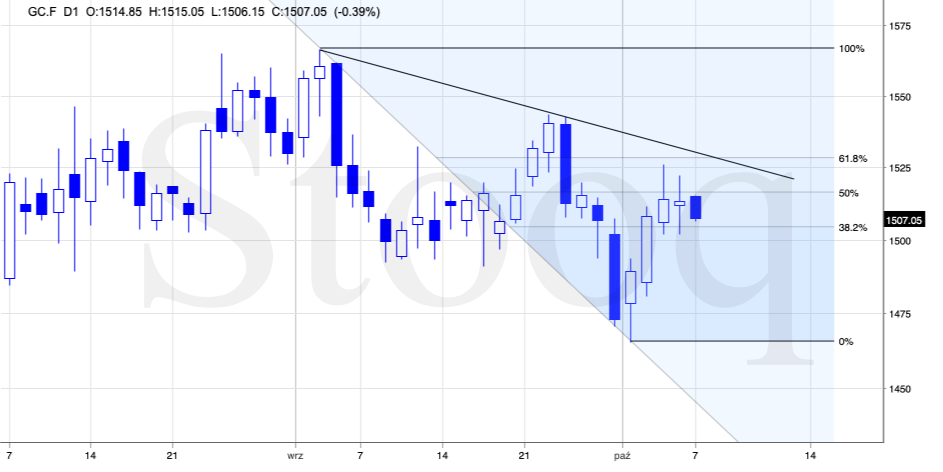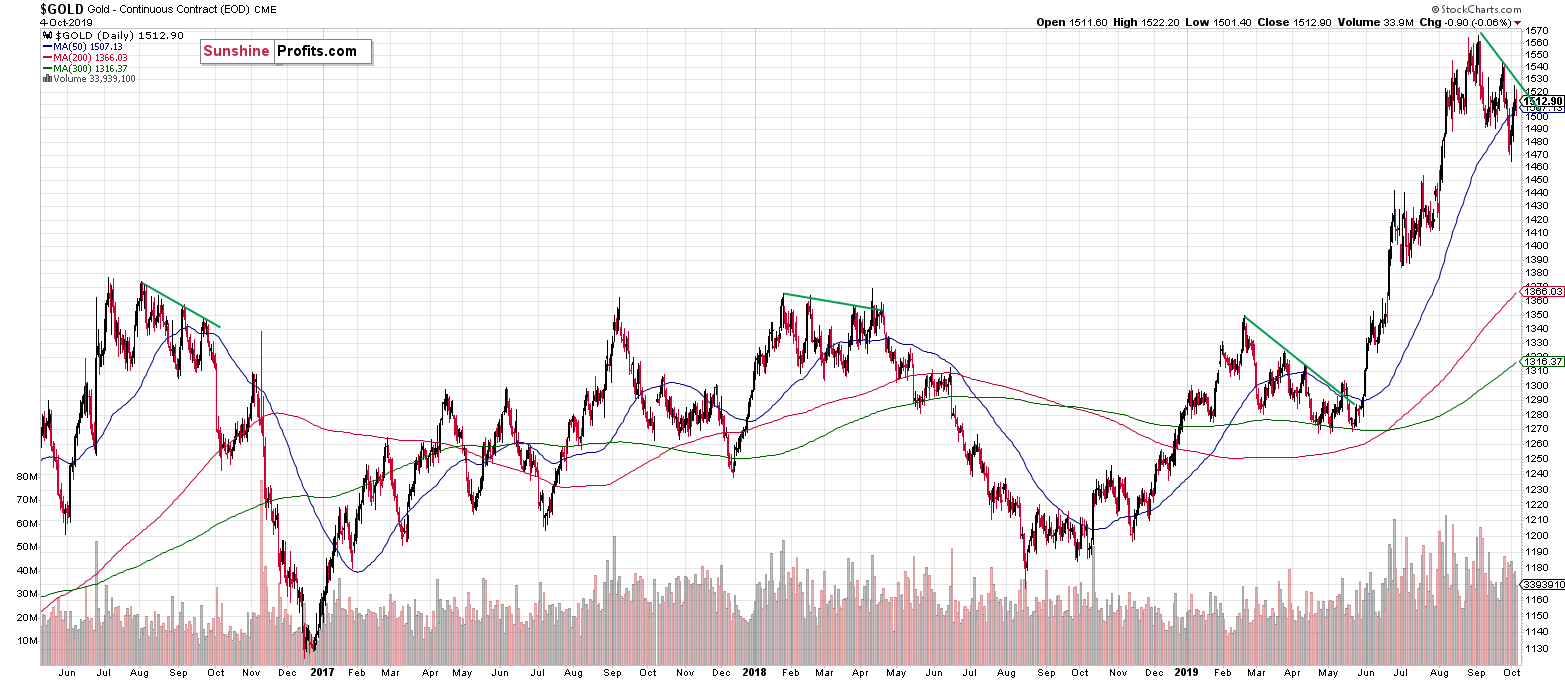Briefly: in our opinion, small (50% of the regular size of the position) speculative long position in gold, silver, and mining stocks are justified from the risk/reward point of view at the moment of publishing this Alert. We are moving the profit-take level for gold lower.
Gold and silver closed Friday's session relatively unchanged, but mining stocks rallied to new October highs. This means changes, but not of the kind most investors would assume.
The above doesn't change either the short-term or medium-term outlook for the precious metals market. Miners' daily strength could be something neutral (it's just one day of strength), or something bullish (miners outperformed gold, after all), which serves as a mild confirmation of the bullish outlook for the very short term. The outlook was already bullish for the very short term, so the above doesn't change it.
The outlook for the medium-term has been bearish based on multiple strong factors and Friday's daily strength doesn't impact any of them. Consequently, the just as the very short-term outlook remains bullish, the medium-term trend remains strongly bearish.
So, what changed? Gold's upside target. It's not because the price moved substantially higher or lower, but because some time passed and the declining resistance line to which gold was likely to move, is now lower.
The Targets Across PMs Now
The resistance line didn't decline tens of dollars, but the decline was significant enough to make our previous profit-take levels too high.
Before zooming in to gold's short-term resistance line, let's consider the intraday performance of silver. It declined initially, but reversed later on and closed the day practically flat. The recovery created a bullish reversal, which has bullish implications for the near term. Having said that, let's take a look at gold.
The resistance line is relatively close, but it wasn't reached yet. The same goes for the 61.8% Fibonacci retracement level based on the September - October decline. As you can see on the above chart, gold is down today, but it's not below either the Friday or Thursday intraday high, which means that it's not really breaking lower.
The declining resistance line and the 61.8% Fibonacci retracement are now very close to Thursday's intraday high, which means that there are now three reasons for gold to reverse after moving to about $1,527. Gold might also move even higher in the very short term, but it's not something we would suggest betting on. The easy to profit part of the rally is the one that ends at the declining resistance line, as that's what's in tune with historical patterns that we described previously:
Based on how close gold is to its resistance line, it seems that it will be first to reach its target. This will create a relatively risky situation from the point of view of the long positions in silver and mining stocks. The bullish signal was strongest in case of gold, so it is very possible that gold will be the only part of the precious metals market that rallies indeed visibly. Consequently, once gold hits its upside target, we think that taking profits off the table and entering a short position in gold, silver, and mining stocks automatically will be justified from the risk to reward point of view.
Our yesterday's comments regarding the likely upside target remain up-to-date.
How high could gold move here? Likely no higher than $1,530 - $1,540, but there's also the possibility that gold will want to once again verify the rising red support line. This means a rally more or less to the previous highs at about $1,560. The latter is not particularly likely though.
Looking at three similar topping patterns, we see that short-term comebacks to the declining resistance lines based on the initial and the following high were quite common. In 2016, 2018, and earlier this year, gold moved back up for at least one more time before declining. In case of the 2016 and 2018 tops, major decline declines followed, whereas earlier this year, we only saw a short-term decline and then yet another rally. Still, we did see a short-term decline first.
Based on the long-term factors and the medium-term situation in the USD Index, it's very likely that the current situation is much more similar to what we saw in 2016 and 2018 than to the first half of 2019. Consequently, the rally back to the declining resistance line is unlikely to change anything with regard to the following huge downswing. But the rally is quite likely to take place, anyway.
When we wrote the above, the declining resistance line was above the $1,530 level. Since now it's lower, the upside target is lower as well.
Naturally, the key bearish factors for the medium term remain intact.
Key Factors to Keep in Mind
Critical factors:
- The USD Index broke above the very long-term resistance line and verified the breakout above it. Its huge upswing is already underway.
- The USD's long-term upswing is an extremely important and bearish factor for gold. There were only two similar cases in the past few decades, when USD Index was starting profound, long-term bull markets, and they were both accompanied by huge declines in gold and the rest of the precious metals market
- Out of these two similar cases, only one is very similar - the case when gold topped in February 1996. The similarity extends beyond gold's about a yearly delay in reaction to the USD's rally. Also the shape of gold price moves prior to the 1996 high and what we saw in the last couple of years is very similar, which confirm the analysis of the gold-USD link and the above-mentioned implications of USD Index's long-term breakout.
- The similarity between now and 1996 extends to silver and mining stocks - in other words, it goes beyond USD, gold-USD link, and gold itself. The white metal and its miners appear to be in a similar position as well, and the implications are particularly bearish for the miners. After their 1996 top, they erased more than 2/3rds of their prices.
- Many investors got excited by the gold-is-soaring theme in the last few months, but looking beyond the short-term moves, reveals that most of the precious metals sector didn't show substantial strength that would be really visible from the long-term perspective. Gold doesn't appear to be starting a new bull market here, but rather to be an exception from the rule.
- Gold's True Seasonality around the US Labor Day points to a big decline shortly.
Very important, but not as critical factors:
- Long-term technical signs for silver, i.a. the analogy in terms of price to what we saw in 2008, shows that silver could slide even below $10.
- Silver's very long-term cycles point to a major reversal taking place right now and since the most recent move was up, the implications are bearish (this is also silver's technical sign, but it's so important that it deserves its own point)
- Long-term technical signs for gold stocks point to this not being a new gold bull market beginning. Among others, it's their long-term underperformance relative to gold that hint this is rather a corrective upswing within a bear market that is not over yet.
- Record-breaking weekly volume in gold is a strong sign pointing to lower gold prices
Important factors:
- Extreme volume reading in the SIL ETF (proxy for silver stocks) is an effective indication that lower values of silver miners are to be expected
- Silver's short-term outperformance of gold, and gold stocks' short-term underperformance of gold both confirm that the precious metals sector is topping here
- Gold topped almost right at its cyclical turning point, which makes the trend reversal more likely
- Copper broke below its head-and-shoulders pattern and confirmed the breakdown. The last time we saw something similar was in April 2013, when the entire precious metals sector was on the verge of plunging lower.
Moreover, please note that while there may be a recession threat, it doesn't mean that gold has to rally immediately. Both: recession and gold's multi-year rally could be many months away - comparing what happened to bond yields in the 90s confirms that.
Copper moved above the neck level of its head-and-shoulders pattern that's based on the intraday lows, but it didn't invalidate the analogous level based on the weekly closing prices, so we don't think it's justified to say that this bearish formation was invalidated at this time.
Summary
Summing up, the big decline in the precious metals sector appears to be finally underway, but based on gold's invalidation of the breakdown below the head-and-shoulders pattern, a quick rally is more likely to take place in the very near term. It's possible that the rally will be very short-lived (it might even end today), or that it will continue until the middle of the month and we see a top based on the triangle-vertex-based reversals in silver and mining stocks that we discussed on Wednesday.
Once gold reaches $1,525, we think that it will be best (from the risk to reward point of view) to take profits off the table in case of the long positions in gold, silver, and mining stocks, and open the big short position in them that are in tune with the main trend. You will find details below.
In other news, we are temporarily (until the end of this week) providing you with access to our Oil & Forex Trading Alerts - until the end of the week you will also receive notifications whenever they are posted.
As always, we'll keep you - our subscribers - informed.
To summarize:
Trading capital (supplementary part of the portfolio; our opinion): Small speculative long position (50% of the full position) in gold, silver, and mining stocks is justified from the risk/reward perspective with the following stop-loss orders and binding exit profit-take price levels:
- Gold: profit-take exit price: $1,524.80; stop-loss: $1,488; initial target price for the UGLD ETN: $144.67; stop-loss for the UGLD ETN: $133.82
- Silver: profit-take exit price: $18.17; stop-loss: $17.16; initial target price for the USLV ETN: $98.96; stop-loss for the USLV ETN: $82.16
- Mining stocks (price levels for the GDX ETF): profit-take exit price: $28.58; stop-loss: $26.27; initial target price for the NUGT ETF: $33.77; stop-loss for the NUGT ETF $25.98
In case one wants to bet on junior mining stocks' prices, here are the stop-loss details and target prices:
- GDXJ ETF: profit-take exit price: $39.47; stop-loss: $35.48
- JNUG ETF: profit-take exit price: $71.48 stop-loss: $51.96
Important: even if gold is the only part of the precious metals market that reaches its upside target, all above-mentioned trades should be closed, and the trades below should be (in our opinion) opened:
Trading capital (supplementary part of the portfolio; our opinion): Once gold reaches $1,529, full speculative short position (250% of the full position) in gold, silver, and mining stocks will be justified from the risk/reward perspective with the following stop-loss orders and exit profit-take price levels:
- Gold: profit-take exit price: $1,391; stop-loss: $1,573; initial target price for the DGLD ETN: $36.37; stop-loss for the DGLD ETN: $25.44
- Silver: profit-take exit price: $16.41; stop-loss: $19.06; initial target price for the DSLV ETN: $20.96; stop-loss for the DSLV ETN: $14.07
- Mining stocks (price levels for the GDX ETF): profit-take exit price: $24.62; stop-loss: $30.11; initial target price for the DUST ETF: $10.32; stop-loss for the DUST ETF $6.08
In case one wants to bet on junior mining stocks' prices, here are the stop-loss details and target prices:
- GDXJ ETF: profit-take exit price: $33.82; stop-loss: $41.22
- JDST ETF: profit-take exit price: $21.58 stop-loss: $12.46
Long-term capital (core part of the portfolio; our opinion): No positions (in other words: cash)
Insurance capital (core part of the portfolio; our opinion): Full position
Whether you already subscribed or not, we encourage you to find out how to make the most of our alerts and read our replies to the most common alert-and-gold-trading-related-questions.
Please note that the in the trading section we describe the situation for the day that the alert is posted. In other words, it we are writing about a speculative position, it means that it is up-to-date on the day it was posted. We are also featuring the initial target prices, so that you can decide whether keeping a position on a given day is something that is in tune with your approach (some moves are too small for medium-term traders and some might appear too big for day-traders).
Plus, you might want to read why our stop-loss orders are usually relatively far from the current price.
Please note that a full position doesn't mean using all of the capital for a given trade. You will find details on our thoughts on gold portfolio structuring in the Key Insights section on our website.
As a reminder - "initial target price" means exactly that - an "initial" one, it's not a price level at which we suggest closing positions. If this becomes the case (like it did in the previous trade) we will refer to these levels as levels of exit orders (exactly as we've done previously). Stop-loss levels, however, are naturally not "initial", but something that, in our opinion, might be entered as an order.
Since it is impossible to synchronize target prices and stop-loss levels for all the ETFs and ETNs with the main markets that we provide these levels for (gold, silver and mining stocks - the GDX ETF), the stop-loss levels and target prices for other ETNs and ETF (among other: UGLD, DGLD, USLV, DSLV, NUGT, DUST, JNUG, JDST) are provided as supplementary, and not as "final". This means that if a stop-loss or a target level is reached for any of the "additional instruments" (DGLD for instance), but not for the "main instrument" (gold in this case), we will view positions in both gold and DGLD as still open and the stop-loss for DGLD would have to be moved lower. On the other hand, if gold moves to a stop-loss level but DGLD doesn't, then we will view both positions (in gold and DGLD) as closed. In other words, since it's not possible to be 100% certain that each related instrument moves to a given level when the underlying instrument does, we can't provide levels that would be binding. The levels that we do provide are our best estimate of the levels that will correspond to the levels in the underlying assets, but it will be the underlying assets that one will need to focus on regarding the signs pointing to closing a given position or keeping it open. We might adjust the levels in the "additional instruments" without adjusting the levels in the "main instruments", which will simply mean that we have improved our estimation of these levels, not that we changed our outlook on the markets. We are already working on a tool that would update these levels on a daily basis for the most popular ETFs, ETNs and individual mining stocks.
Our preferred ways to invest in and to trade gold along with the reasoning can be found in the how to buy gold section. Additionally, our preferred ETFs and ETNs can be found in our Gold & Silver ETF Ranking.
As a reminder, Gold & Silver Trading Alerts are posted before or on each trading day (we usually post them before the opening bell, but we don't promise doing that each day). If there's anything urgent, we will send you an additional small alert before posting the main one.
=====
Latest Free Trading Alerts:
Many believe that negative interest rates will never arrive to the United States. This can't possibly happen here. The discussions of their theoretical benefits almost remind you of the not-in-my-backyard mentality. But this is not true - they are already present in America. Hard to believe it? Hiding in plain sight, let's take it a step further and look at gold in the negative real interest rates environment.
Gold in the Negative Real Interest Rates Environment
The markets were shaken by PMI numbers releases last week. And it was worth paying attention to our last week's News Calendar, as we pointed them out early in the week. This week, we will have some potentially moving news releases too. So let's take a look at those events.
Important Economic News Calendar: October 7 - October 11, 2019
=====
Thank you.
Sincerely,
Przemyslaw Radomski, CFA
Editor-in-chief, Gold & Silver Fund Manager






